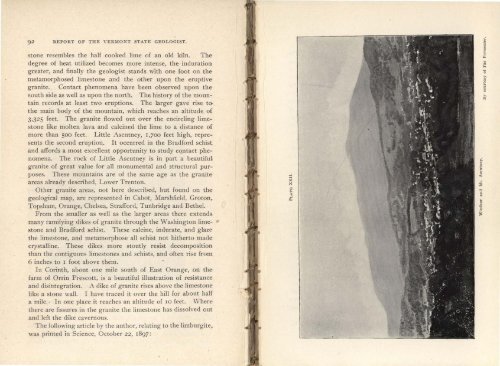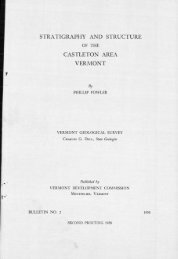Mineral Industries and Geology of Certain Areas - Vermont Agency ...
Mineral Industries and Geology of Certain Areas - Vermont Agency ...
Mineral Industries and Geology of Certain Areas - Vermont Agency ...
Create successful ePaper yourself
Turn your PDF publications into a flip-book with our unique Google optimized e-Paper software.
92 REPORT OF THE VERMONT STATE GEOLOGIST.<br />
t<br />
stone resembles the half cooked lime <strong>of</strong> an old kiln. The<br />
degree <strong>of</strong> heat utilized becomes more intense, the induration<br />
greater, <strong>and</strong> finally the geologist st<strong>and</strong>s with one foot on the<br />
metamorphosed limestone <strong>and</strong> the other upon the eruptive<br />
granite. Contact phenomena have been observed upon the<br />
south side as well as upon the north. The history <strong>of</strong> the mountain<br />
records at least two eruptions. The larger gave rise to<br />
the main body <strong>of</strong> the mountain, which reaches an altitude <strong>of</strong><br />
3,325 feet. The granite flowed out over the encircling limestone<br />
like molten lava <strong>and</strong> calcined the lime to a distance <strong>of</strong><br />
more than 500 feet. Little Ascutney, 1,700 feet high, represents<br />
the second eruption. It occurred in the Bradford schist<br />
<strong>and</strong> affords a most excellent opportunity to study contact phenomena.<br />
The rock <strong>of</strong> Little Ascutney is in part a beautiful<br />
granite <strong>of</strong> great value for all monumental <strong>and</strong> structural purposes.<br />
These mountains are <strong>of</strong> the same age as the granite<br />
areas already described, Lower Trenton.<br />
Other granite areas, not here described, but found on the<br />
geological map, are represented in Cabot, Marshfield, Groton<br />
Topsham, Orange, Chelsea, Strafford, Tunbridge <strong>and</strong> Bethel.<br />
From the smaller as well as the larger areas there extends.<br />
many ramifying dikes <strong>of</strong> granite through the Washington limestone<br />
<strong>and</strong> Bradford schist. These calcine, indurate, <strong>and</strong> glaze<br />
the limestone, <strong>and</strong> metamorphose all schist not hitherto made<br />
crystalline. These dikes more stoutly resist decomposition<br />
than the contiguous limestones <strong>and</strong> schists, <strong>and</strong> <strong>of</strong>ten rise from<br />
6 inches to i foot above them.<br />
In Corinth, about one mile south <strong>of</strong> East Orange, on the<br />
farm <strong>of</strong> Orrin Prescott, is a beautiful illustration <strong>of</strong> resistance<br />
<strong>and</strong> disintegration. A dike <strong>of</strong> granite rises above the limestone<br />
like a stone wall. I have traced it over the hill for about half<br />
a mile. In one place it reaches an altitude <strong>of</strong> io feet. Where<br />
there are fissures in the granite the limestone has dissolved out<br />
<strong>and</strong> left the dike cavernous.<br />
The following article by the author, relating to the limburgite,<br />
was printed in Science, October 22, 1897:<br />
C













